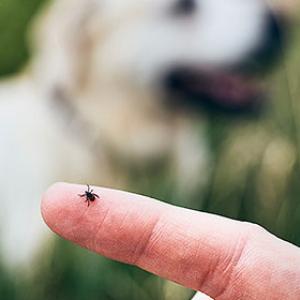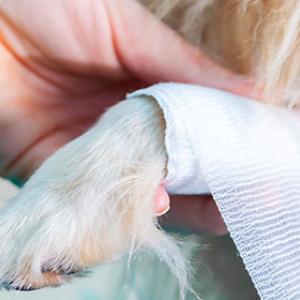Food incompatibility in dogs
The collective term ‘food incompatibilities’ includes allergies or intolerances to certain food components. The two terms are to be distinguished as follows:
Food allergies
An allergy is a reaction of the immune system. Normally harmless components in food trigger an (over)reaction of the body, like a pathogen. Among other things, food allergies can lead to permanent itching, skin inflammations or gastrointestinal symptoms in dogs.
In a true food allergy, the immune system almost always reacts to certain proteins that the dog eats.
Food intolerance
With food intolerance, on the other hand, the immune defence does not play a role. It is a direct reaction of the body to certain ingredients (e.g. dairy products, cereals...), which can manifest itself as vomiting and diarrhoea, bloating, abdominal pain or loss of appetite. Dogs are also lactose intolerant, i.e. they suffer from digestive disorders due to a lack of the enzyme lactase, which breaks down lactose, especially in young animals.
The dog can also react with digestive disorders to food additives such as preservatives and colourings, as well as medicines.
Cause of food incompatibility
So far, there is no scientific confirmation of concrete risk factors. Possible triggers can include gastrointestinal diseases, for example. These diseases, caused by bacteria or viruses, increase the permeability of the intestinal mucosa. Proteins that are too ‘big’ pass through the ‘protective barrier’ of the intestine and cause a reaction of the immune system. But immunodeficiencies and genetic predispositions are also among the risk factors.
In most cases, therefore, the actual cause of a reaction to food components is unknown and a clear distinction between immunological and non-immunological causes is also not possible. Therefore, the terms food allergy and food intolerance are often combined under the umbrella term ‘food incompatibility’.

Symptoms of an incompatibility
Normal dog food is digested by healthy dogs without any problems. In contrast, dogs with a food allergy often have a reaction after eating a particular food that they cannot tolerate: diarrhoea, vomiting, flatulence, a distended abdomen or skin inflammation and irritation as well as flaky skin. Hair loss, ear and anal gland infections, unpleasant odour from the ears, loss of appetite and apathy can be further consequences.
It is important to note that these can only be indications. The symptoms should be discussed with your vet, as they could also be caused by other diseases.
Other allergy triggers
In addition to a food allergy, an environmental allergy (pollen, contact allergies to the dog’s harness, for example), a flea saliva allergy or also parasites (fleas, mites), skin fungi, infections as well as behavioural problems (e.g. licking paws due to boredom) can also be the cause of itching and skin changes. Diarrhoea can also have many causes: gastrointestinal infections, stress (travelling, moving house, also positive stress), medication or deworming, parasite infestation, organ damage, etc.
Diagnosing a food allergy
Food allergies are relatively common in dogs. However, it is difficult to reliably detect a true feed allergy. The search for the cause is carried out exclusively through a strict exclusion diet, or elimination diet. Blood tests are often offered, but their significance is very questionable, and they do not detect any incompatibilities.
An exclusion diet is started with food ingredients that the dog has never had before. This means both a new type of meat and a new carbohydrate source. Once you have decided which food to give your dog, it must be fed for at least 8 weeks.
Consistency during an exclusion diet
The indispensable basis of this diet is the consistent adherence to this strict eating plan. You and people around you must not feed any additional food at all during this time. This includes treats, special treats (such as pig ears, ox pizzle or bovine scalp) and especially treats from the table. This is because anything that the dog has in its mouth during this time can possibly trigger a reaction in the skin or digestive tract – and thus falsify the result. As snacks for in between, you can take the selected dog food (and subtract this amount from the daily ration). During walks, make sure that your four-legged friend does not help himself to anything. If in doubt, always walk your dog on a leash for this period. Only if the diet is carried out consistently can it give the desired result and provide information about the food allergy or food incompatibility and lead to a reduction in symptoms. These will not decrease immediately, but from about the second or third week onwards, or even disappear altogether once the right food has been found for your dog. On average, you need 3 to 4 attempts until this goal is reached.
Pay attention to the food!
When implementing such a diet, it is also important to take a close look at the label of the new food in advance. This is because information such as ‘meat and animal by-products (min. 4% xy)’ does not clearly indicate what other types of meat are involved. Therefore, ask the manufacturer more precisely or opt for dog food with an open declaration. You can find more on this topic in the article ‘Declaration of dog food’.
If your four-legged friend is on medication, discuss the ingredients with your vet with regard to the exclusion diet. The same applies to additional food and supplements if you cannot generally omit them. Some medicines or even dewormers given in the form of chewable tablets often contain meat meal or other animal ingredients to improve acceptance.
Once you have found the right food and your dog is symptom-free, it is advised to follow a so-called provocation diet, where a counter-reaction (a ‘provocation’) is induced. To do this, you need to feed your dog previous food components again step by step and wait to see if symptoms reappear. A reaction can occur anywhere from a few hours to several days after ingestion. In this case, take a step back and go back to the original exclusion diet until the symptoms have disappeared.
It is advisable to keep records over the entire period. We provide you with a free template for your personal food diary.
Product recommendations
The benefits of PLATINUM dog food
- PLATINUM uses a unique preparation method called FSG, which offers numerous advantages compared to conventional dog food.
- Dog food prepared with FSG is gently cooked only in its own meat juice and is therefore nutrient-rich like BARF, excellent for building muscles and also extra tasty for your dog.
- With at least 70% fresh meat in the dry dog food and 83% fresh meat or fresh fish in the wet dog food, PLATINUM places great value on a composition of the food that is adapted to the needs of dogs.
- The declaration and composition of dog food prepared with FSG is tested regularly and independently by ELAB Analytik GmbH (formerly TÜV SÜD ELAB) - for canine health protection.
- PLATINUM is generally very well accepted by dogs of all breeds and ages. Even four-legged friends with sensitive digestion or intolerances usually tolerate PLATINUM dog food well.
- All products are free of soya, GMOs and gluten. In addition, no flavour enhancers, attractants, odourants or colourings are used.
- Over 2,000 positive customer reviews at Trusted Shops speak for themselves!










.png)
.png)
